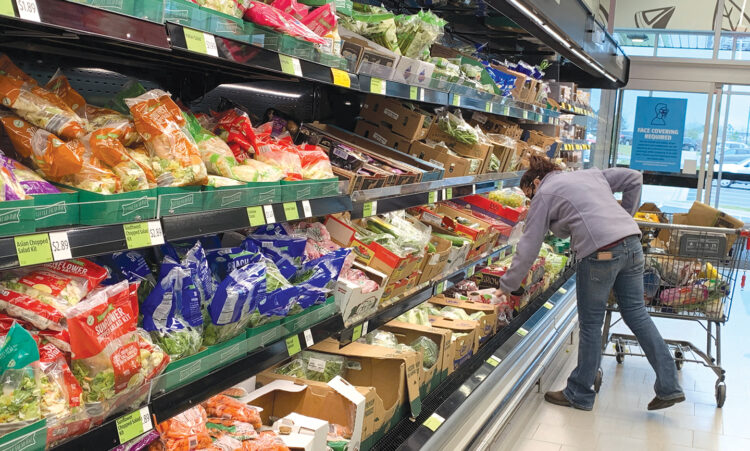
ALDI / Jason Benavides file photo
June 13. Rising food costs hurt. Indeed, from January to mid-May, prices for basic items we compared at five Cornelius grocery stores rose 9.4 percent.
Breaking: The US food index increased 10.1 percent for the 12-months ending May, the first increase of 10 percent or more since the period ending March 1981.
Comparing our local markets
For the latest Cornelius Today grocery price check-in, prices were gathered May 19, and do not reflect sales or special promotions. Alternative/store brands were priced when the brand name product was not sold; this is noted in the chart. The May 19 prices are compared with prices for the same items gathered on Jan. 22 this year. See the chart here.
The same items at…
—Aldi cost $29.94 in January and $38.47 in May, up 28 percent.
• Prices were up 24 percent from November 2020 to January this year.
—Food Lion, $44.94 in January and $49.53 in May, up 10 percent.
• Prices were up 12 percent from November 2020 to January this year.
—Harris Teeter, $48.16 in January and $48.76 in May, up 1 percent.
• Prices were up 7 percent from November 2020 to January this year.
—Publix, $46.73 in January and $49.46 in May, up 6 percent.
• Prices were up 7 percent from November 2020 to January this year
—The Fresh Market, $56.76 in January and $58.26 in May, up 2 percent.
• Prices were up 15 percent from November 2020 to January this year.
TIPS FOR SHOPPERS
Caroline Garrison, a registered dietitian with Novant Health Bariatric Solutions offers these suggestions for getting the best value at a grocery store:
• Shop generic brands.
• Shop the in-store sales, typically grocery stores have one “main” sale per week.
• Purchase bulk items, especially protein sources (meats) this tends to be a better deal and save money in the long run. Freeze what you do not use for later.
• Limit food waste.
• Canned tuna/fish provides great protein if fresh fish is too expensive.
• Purchase frozen fruit/vegetables making sure that the fruit is in its own juices with no added sugar or syrup and the vegetables have no added sauces/seasoning.
“Frozen fruit is still a very nutritious option and contains just as much nutrition and fiber as fresh fruit,” Garrison says.
Have a plan
To make your grocery budget work better, Garrison suggests going into the store with a plan and grocery list. When planning meals for the week, choose meals that use some of the same ingredients to help save on cost.
“Spend grocery money on nutritious options that you could prepare multiple meals with,” she says. “Try to avoid spending money on empty calorie food items or overpriced products that will not provide you with adequate nutrition.”
Another idea is to try shopping online so you can monitor your budget as you shop, Garrison says.
Milk options
Nutrition-wise, it is hard to beat the benefits and nutrition profile of cow’s milk. One cup is packed with 8 grams of protein, has a good amount of carbohydrates and fat, making it a well-balanced milk option. Cow’s milk is also a wonderful source of other important nutrients such as calcium, B-12, and potassium. Most cow’s milk is also fortified with Vitamin D, which aids with calcium absorption. It is difficult to find many food sources of Vitamin D to include in your diet, and cow’s milk is one of them.
Other milk options such as soy, almond or oat milk are decent alternatives to cow’s milk. Soy milk is going to have the most protein when compared to almond or oat milk. Most milk alternatives are also fortified with vitamins/minerals that vegans or vegetarians may struggle to get adequate amounts of.
“As always, I encourage consumers to spend some time looking and comparing food labels to see which product would best fit their needs,” Garrison says.
Bread options: Is cheaper bread OK?
Cheaper bread is OK, especially if that is all you can afford to purchase.
For bread and all food items, it is important to look at the food label and compare labels between various products. Sometimes the brown color just means that molasses has been added.
“Whole wheat” doesn’t always mean “whole grain” and this can be tricky.
Ideally, the first item on the ingredient list should say whole grain. Whole grains contain all three parts of the grain and are minimally processed. Whole grains contain more vitamins, antioxidants and fiber. Grains can be a great source of fiber, I would look for at least 2 grams of fiber for each slice of bread. Some breads can also be higher in sodium, if it is high (greater than 200mg/serving) compare brands and try to choose the lowest option that still fits within your budget.




